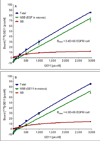PolyIC GE11 polyplex inhibits EGFR-overexpressing tumors
- PMID: 22362419
- PMCID: PMC3711802
- DOI: 10.1002/iub.1002
PolyIC GE11 polyplex inhibits EGFR-overexpressing tumors
Abstract
Phage display has identified the dodecapeptide YHWYGYTPQNVI (GE11) as a ligand that binds to the epidermal growth factor receptor (EGFR) but does not activate the receptor. Here, we compare the EGFR binding affinities of GE11, EGF, and their polyethyleneimine-polyethyleneglycol (PEI-PEG) conjugates. We found that although GE11 by itself does not exhibit measurable affinity to the EGFR, tethering it to PEI-PEG increases its affinity markedly, and complex formation with polyinosine/cytosine (polyIC) further enhances the affinity to the submicromolar range. PolyIC/PPGE11 has a similar strong antitumor effect against EGFR overexpressing tumors in vitro and in vivo, as polyIC/polyethyleneimine-polyetheleneglycol-EGF (polyIC/PP-EGF). Absence of EGFR activation, as previously shown by us and easier production of GE11 and GE11 conjugates, confer polyIC/PPGE11 a significant advantage over similar EGF-based polyplexes as a potential therapy of EGFR overexpressing tumors.
Copyright © 2012 Wiley Periodicals, Inc.
Figures




Similar articles
-
EGFR-homing dsRNA activates cancer-targeted immune response and eliminates disseminated EGFR-overexpressing tumors in mice.Clin Cancer Res. 2011 Mar 1;17(5):1033-43. doi: 10.1158/1078-0432.CCR-10-1140. Epub 2010 Dec 30. Clin Cancer Res. 2011. PMID: 21196415 Free PMC article.
-
Peptide GE11-Polyethylene Glycol-Polyethylenimine for targeted gene delivery in laryngeal cancer.Med Oncol. 2015 Jul;32(7):185. doi: 10.1007/s12032-015-0624-9. Epub 2015 May 26. Med Oncol. 2015. PMID: 26008151
-
Disconnecting the yin and yang relation of epidermal growth factor receptor (EGFR)-mediated delivery: a fully synthetic, EGFR-targeted gene transfer system avoiding receptor activation.Hum Gene Ther. 2011 Dec;22(12):1463-73. doi: 10.1089/hum.2010.231. Epub 2011 Aug 10. Hum Gene Ther. 2011. PMID: 21644815 Free PMC article.
-
Challenges for the application of EGFR-targeting peptide GE11 in tumor diagnosis and treatment.J Control Release. 2022 Sep;349:592-605. doi: 10.1016/j.jconrel.2022.07.018. Epub 2022 Jul 22. J Control Release. 2022. PMID: 35872181 Review.
-
Epidermal growth factor receptor: Structure-function informing the design of anticancer therapeutics.Exp Cell Res. 2018 Oct 1;371(1):1-19. doi: 10.1016/j.yexcr.2018.08.009. Epub 2018 Aug 9. Exp Cell Res. 2018. PMID: 30098332 Review.
Cited by
-
Targeting the Immune System to Fight Cancer Using Chemical Receptor Homing Vectors Carrying Polyinosine/Cytosine (PolyIC).Front Oncol. 2012 Feb 8;2:4. doi: 10.3389/fonc.2012.00004. eCollection 2012. Front Oncol. 2012. PMID: 22649773 Free PMC article.
-
Synthesis, Microtubule-Binding Affinity, and Antiproliferative Activity of New Epothilone Analogs and of an EGFR-Targeted Epothilone-Peptide Conjugate.Int J Mol Sci. 2019 Mar 5;20(5):1113. doi: 10.3390/ijms20051113. Int J Mol Sci. 2019. PMID: 30841526 Free PMC article.
-
Towards Radiolabeled EGFR-Specific Peptides: Alternatives to GE11.Pharmaceuticals (Basel). 2023 Feb 11;16(2):273. doi: 10.3390/ph16020273. Pharmaceuticals (Basel). 2023. PMID: 37259420 Free PMC article.
-
GE11 Peptide as an Active Targeting Agent in Antitumor Therapy: A Minireview.Pharmaceutics. 2017 Dec 22;10(1):2. doi: 10.3390/pharmaceutics10010002. Pharmaceutics. 2017. PMID: 29271876 Free PMC article. Review.
-
In silico studies of interactions of peptide-conjugated cholesterol metabolites and betulinic acid with EGFR, LDR, and N-terminal fragment of CCKA receptors.J Mol Model. 2021 Dec 28;28(1):16. doi: 10.1007/s00894-021-05007-5. J Mol Model. 2021. PMID: 34961887
References
-
- Levitzki A. Frontiers in Oncology. 2011 in press.
-
- Kim IY, Kang YS, Lee DS, Park HJ, Choi EK, Oh YK, Son HJ, Kim JS. J Control Release. 2009;140:55–60. - PubMed
-
- Diagaradjane P, Orenstein-Cardona JM, Colon-Casasnovas NE, Deorukhkar A, Shentu S, Kuno N, Schwartz DL, Gelovani JG, Krishnan S. Clin Cancer Res. 2008;14:731–741. - PubMed
Publication types
MeSH terms
Substances
Grants and funding
LinkOut - more resources
Full Text Sources
Other Literature Sources
Research Materials
Miscellaneous

